The Negative Effect of “Hardening” Schools on Students of Color

By Nicole Dooley, Policy Counsel at NAACP Legal Defense and Educational Fund, Inc., and Rachel Marshall, Federal Policy Counsel for the Campaign for Youth Justice
After the February 14, 2018, shooting at Marjory Stoneman Douglas High School in Parkland, Florida, people across the country again started having too-familiar conversations around how to keep students safe from violence at school. These conversations covered a wide range of topics, from students discussing clear backpacks, to teachers and administrators taking emergency preparedness trainings, to state and federal lawmakers deciding how to spend money to make schools safer.
One important part of the conversation, often overlooked, is the effect of these school safety efforts on underserved students, and in particular, students of color. Human behavior is often influenced by subconscious beliefs and stereotypes, called implicit bias. In the school setting, this often results in students of color being disparately impacted by school policies and practices. White adults who work with children view Black, Hispanic, and American Indian children as being more violence-prone and less intelligent than their white peers. These types of assumptions lead to students of color, particularly Black students, being disciplined and arrested at school at higher rates than their white peers despite similar behavior. Although this happens on an individual basis, it also happens more systemically – different schools have different levels of services and different outcomes based on the demographics of the schools’ students. For example, schools that are majority Black have more security personnel than schools that are majority white.
Because of these existing disparities, pushes to increase physical security measures and the number of police in schools in the wake of school shootings are concerning. There is no evidence or research to show that having school police officers or physical security measures like metal detectors makes schools or students safer, but evidence does show that a disproportionate percentage of these measures will likely be put in place in majority Black schools and will lead to higher racial disparities in school discipline and school-based arrests.
Civic engagement is so important in making sure that knee-jerk reactions to school shootings are not pushing children into the school-to-prison pipeline. Law and policy makers instead need to research and understand what keeps students safe, whether it is improving school climate, providing quality mental health services, or making sure children feel like they belong and are trusted at school. Citizens can do their part by engaging with decision-makers, through voting or calling elected officials or speaking at school board meetings or submitting comments to the Department of Education or any other activities that will let their voice be heard. As we approach November 6, the Campaign for Youth Justice is urging you to take the pledge to #VoteYouthJustice. And as Election Day approaches, make sure you are engaging with your elected officials and local candidates to learn where they stand on issues that impact youth justice, like school climate. Together, we can work to ensure all young people are safe in their schools.

